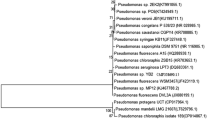Abstract
Malachite green (MG), a widely-used and recalcitrant dye, has been confirmed to be carcinogenic and mutagenic against many organisms. The main objective of this study is to investigate the capability of Pseudomonas sp. strain DY1 to decolorize MG, and to explore the possible mechanism. The results showed that this strain demonstrated high decolorizing capability (90.3–97.2%) at high concentrations of MG (100–1,000 mg/l) under shaking condition within 24 h. In static conditions, lower but still effective decolorization (78.9–84.3%) was achieved. The optimal pH and temperature for the decolorization was pH 6.6 and 28–30°C, respectively. Mg2+ and Mn2+ (1 mM) were observed to significantly enhance the decolorization. The intermediates of the MG degradation under aerobic condition identified by UV–visible, GC–MS and LC–MS analysis included malachite green carbinol, (dimethyl amino-phenyl)-phenyl-methanone, N,N-dimethylaniline, (methyl amino-phenyl)-phenyl-methanone, (amino phenyl)-phenyl methanone and di-benzyl methane. The enzyme analysis indicated that Mn-peroxidase, NADH–DCIP and MG reductase were involved in the biodegradation of MG. Moreover, phytotoxicity of MG and detoxification for MG by the strain were observed. Therefore, this strain could be potentially used for bioremediation of MG.






Similar content being viewed by others
References
Ayed L, Chaieb K, Cheref A, Bakhrouf A (2009) Biodegradation of triphenylmethane dye malachite green by Sphingomonas paucimobilis. World J Microbiol Biotechnol 25:705–711
Bermek H, Gülseren I, Li K, Jung H, Tamerler C (2004) The effect of fungal morphology on ligninolytic enzyme production by a recently isolated wood-degrading fungus Trichophyton rubrum LSK-27. World J Microbiol Biotechnol 20:345–349
Chen CY, Kuo JT, Cheng CY, Huang YT, Ho IH, Chung YC (2009) Biological decolorization of dye solution containing malachite green by Pandoraea pulmonicola YC32 using a batch and continuous system. J Hazard Mater 172:1439–1445
Chen CH, Chang CF, Liu SM (2010) Partial degradation mechanisms of malachite green and methyl violet B by Shewanella decolorationis NTOU1 under anaerobic conditions. J Hazard Mater 177:281–289
Chhabra M, Mishra M, Sreekrishnan TR (2009) Laccase/mediator assisted degradation of triarylmethane dyes in a continuous membrane reactor. J Biotechnol 143:69–78
Daneshvar N, Khataee AR, Rasoulifard MH, Pourhassan M (2007) Biodegradation of dye solution containing malachite green: optimization of effective parameters using Taguchi method. J Hazard Mater 143:214–219
Deng D, Guo J, Zeng G, Sun G (2008) Decolorization of anthraquinone, triphenylmethane and azo dyes by a new isolated Bacillus cereus strain DC11. Int Biodeterior Biodegrad 62:263–269
Fessard VT, Godard T, Huet S, Mourot A, Poul JM (1999) Mutagenicity of malachite green and leucomalachite green in vitro tests. J Appl Toxicol 19:421–430
Forgacs E, Cserháti T, Oros G (2004) Removal of synthetic dyes from wastewaters: a review. Environ Int 30:953–971
Hameed BH, Lee TW (2009) Degradation of malachite green in aqueous solution by Fenton process. J Hazard Mater 164:468–472
Han R, Wang Y, Sun Q, Wang L, Song J, He X, Dou C (2010) Malachite green adsorption onto natural zeolite and reuse by microwave irradiation. J Hazard Mater 175:1056–1061
Jadhav JP, Govindwar SP (2006) Biotransformation of malachite green by Saccharomyces cerevisiae MTCC 463. Yeast 23:315–323
Kalyani DC, Patil PS, Jadhav JP, Govindwar SP (2008) Biodegradation of reactive textile dye Red BLI by an isolated bacterium Pseudomonas sp. SUK1. Bioresour Technol 99:4635–4641
Kammoun MM, Mechichi HZ, Belbahri L, Woodward S, Mechichi T (2009) Malachite green decolourization and detoxification by the laccase from a newly isolated strain of Trametes sp. Int Biodeterior Biodegrad 63:600–606
Li LT, Hong Q, Yan X, Fang GH, Ali SW, Li SP (2009) Isolation of a malachite green-degrading Pseudomonas sp. MDB-1 strain and cloning of the tmr2 gene. Biodegradation 20:769–776
Papinutti L, Mouso N, Forchiassin F (2006) Removal and degradation of the fungicide dye malachite green from aqueous solution using the system wheat bran–Fomes sclerodermeus. Enzyme Microb Technol 39:848–853
Parshetti G, Kalme S, Saratale G, Govindwar S (2006) Biodegradation of malachite green by Kocuria rosea MTCC 1532. Acta Chim Slov 53:492–498
Rahman IA, Saad B, Shaidan S, Sya Rizal ES (2005) Adsorption characteristics of malachite green on activated carbon derived from rice husks produced by chemical–thermal process. Bioresour Technol 96:1578–1583
Sani RK, Banerjee UC (1999) Decolorization of triphenylmethane dyes and textile and dye-stuff effluent by Kurthia sp. Enzyme Microb Technol 24:433–437
Shedbalkar U, Dhanve R, Jadhav J (2008) Biodegradation of triphenylmethane dye cotton blue by Penicillium ochrochloron MTCC 517. J Hazard Mater 157:472–479
Srivastava S, Sinha R, Roy D (2004) Toxicological effects of malachite green. Aquat Toxicol 66:319–329
Tien M, Kirk TK (1988) Lignin peroxidase of Phanerochaete chrysosporium. Methods Enzymol 161:238–249
Van der Zee FP, Villaverde S (2005) Combined anaerobic–aerobic treatment of azo dyes—a short review of bioreactor studies. Water Res 39:1425–1440
Wu J, Jung BG, Kim K-S, Lee Y-C, Sung N-C (2009) Isolation and characterization of Pseudomonas otitidis WL-13 and its capacity to decolorize triphenylmethane dyes. J Environ Sci 21:960–964
Acknowledgments
This study was supported by the National Hi-Tech Research and Development Program (863) of China (No. 2007AA06Z329), the Science and Technology Project of Zhejiang Province (2008C13014-3), the National Natural Science Foundation of China (31070079), and the International Cooperation Project in Science and Technology of Zhejiang Province (No. 2008C14038). The authors are grateful to Bipei Chen in USA and Professor Qifa Zhou (College of Life Science, Zhejiang University) for improving the manuscript; and Xinhang Jiang (Equipment and Technology Service platform, College of Life Science, Zhejiang University) for analyzing the products of biodegradation of MG using LC–MS.
Author information
Authors and Affiliations
Corresponding authors
Rights and permissions
About this article
Cite this article
Du, LN., Wang, S., Li, G. et al. Biodegradation of malachite green by Pseudomonas sp. strain DY1 under aerobic condition: characteristics, degradation products, enzyme analysis and phytotoxicity. Ecotoxicology 20, 438–446 (2011). https://doi.org/10.1007/s10646-011-0595-3
Accepted:
Published:
Issue Date:
DOI: https://doi.org/10.1007/s10646-011-0595-3




